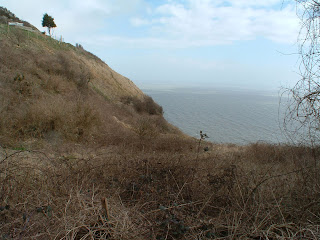Fiction Writing – A Sense of Place
 |
| Photo Copyright Janet Cameron |
When writing fiction, a sense of place is paramount. Charles
Dickens and Elizabeth Gaskell knew this, and because their fiction is
grounded in place, the Victorian era becomes real for us – and so
do the characters in the books. Think of the bleakness of the marshes
where the prison ships (the hulks) lay brooding in Great
Expectations.
Paradoxically, in Great Expectations, an old woman’s living death becomes alive for us today through Dickens’ evocative language, for who can forget Miss Havisham in her dusty room with her drooping wedding dress and decaying cake?
Paradoxically, in Great Expectations, an old woman’s living death becomes alive for us today through Dickens’ evocative language, for who can forget Miss Havisham in her dusty room with her drooping wedding dress and decaying cake?
In
North and South, Elizabeth Gaskell contrasts the values of the
industrial north of England and the rural south and these differences
inform both plot and the development of her characters.
What
is essential, and also most difficult, is to impart the sense of
place naturally within the writing. Today, we write differently from
the Victorians, tending to avoid lengthy blocks of description which
can be off-putting, particularly when they appear early on in the
work, a practice frequently explained away as ‘scene setting’. If
the essence of place is worked simply as another thread of the story,
like dialogue and characterisation, the narrative pace is
uninterrupted while nothing is lost.
The
scene does not need to set. It needs to live, to be a vibrant,
integrated part of the writing, shaping and reflecting the lives,
moods and emotions of your characters.
Being
There
Ideally,
spend time in the place you are writing about, but sometimes this may
not be possible. For example, you may be writing of past times or
even about inaccessible or imagined places as in fantasy writing. You
can still do your research thoroughly, watch videos, discuss with
friends who will share their perceptions. If, however, you can ‘Be
There’ even if only for a short while, your writing may gain in
depth, detail and colour.
Importantly,
being there offers you the specific rather than the general. The sea
is easily described, rolling against the seawall and up the steps.
But being there eventually produced: ‘The tide is in and little
waves rush at the steps, bounce up them, one, two, three at a time,
precocious, as though they are very young and haven’t quite got the
hang of it.’
Only
standing, watching and reflecting produced that extra small
perception and personification. A contrast and a connection was
created between the young waves and the central protagonist, a
middle-aged, mentally-ill patient who is as vulnerable as a small
child and who feels inadequate to deal with the situation created for
her. A sense of place closely related to, or contrasting with, your
character intensifies the impact.
Of
course, some writers manage to produce fantastic prose without
actually being there, most touchingly, the author, Stephen Crane who
wrote The Red Badge of Courage without ever going to war. But
specific language is more easily inspired by specific observation.
Remember, though, that smart sentences don’t always pop into your
head at the time of the experience. Mostly, it’s a matter of taking
copious notes, allowing them to germinate in the ether for a time and
then reflecting on them later.
Concrete
Imagery
A
favourite exercises for developing concrete imagery in writing is to
describe a place from the senses of smell, hearing, taste and touch.
Sight is excluded. You are not allowed to say how the place
looks, although, you could add those impressions later. They’re
still important, but let’s fully explore all our senses, not just
the obvious one.
Familiar
smells of childhood can take you back in just an instant. How did
your dog smell after it had been swimming in the garden pond? Try to
do better than just saying ‘foul’. What foul ingredients can you
conjure up to describe the smell? What did sherbet dabs taste like,
especially when you stuck spearmint lollipops into the powder? Taste
is tricky to describe, but it can be used as an abstract. You could
taste the fear or you could savour the sweetness of your first
lover’s lips. Now feel the loving caress of your mother’s
fingertips tracing the contours of your cheek. The physicality of
these sensations can help you to convey to your readers what you
feel, sense what you sense and be wherever you are in your story.
Concrete
imagery helps you to relate a sense of place directly from your
character’s viewpoint or experience. Experiment with language and
ideas. Experiment with colour and texture, with light and shade, with
what needs to subtle and what works best overtly stated. Allow your
reader to engage with the scene as it reflects the psychology, mood
or emotional make-up of a character.
Your reader wants to feel as if
they are there with you.
Adapted
from: 'How to make your stories come alive' by Janet Cameron,
Writers'
Forum,
June, 20


Comments